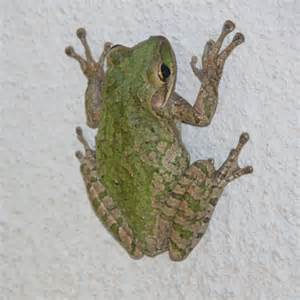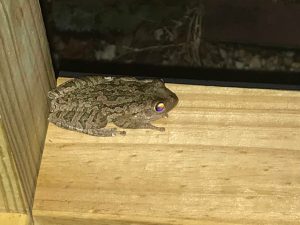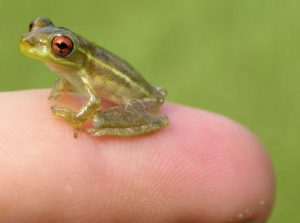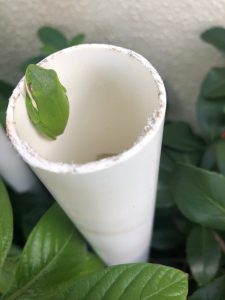We have written about these invasive animals before. But I recently returned from an extended vacation to find one report of a Cuban treefrog in Escambia County, in the Perdido Key area, and my colleague in Santa Rosa saying she had heard from several folks about them – and even had some brought into the office. I am not sure of the total number, but enough to catch our attention.

Photo: UF IFAS
So, why should we be concerned about an increase in Cuban Treefrogs?
Well, it is like the increase of any invasive species. By definition, invasive species are problems and the best way to reduce the problem is to either prevent them from getting here or manage them early in their invasion.
The frog is from the Caribbean and reached Florida’s shores in the early 20th century. They have slowly dispersed northward and were reported as established as far north as Gainesville. The invasive database EDDMapS currently has 2,127 reports of Cuban treefrogs across the United States. This is certainly under reported. There have been two reports outside if the south, one in Massachusetts and one in New York. Within the south there are two reports outside of Florida, one in Tennessee and one in Louisiana. I know that there is an established population in the New Orleans area. The remaining 2,123 are in Florida. 18 of those are in the Florida panhandle, and six from the Pensacola Bay area. I am aware of three records prior to this year. We now know that one population in Bay County is breeding. This population had several members of different age classes and it was monitored this past year to determine whether it could survive north Florida winters. The population appears to be doing well.
The problems include both environmental and economic ones. They reproduce aggressively and consume a variety of smaller native wildlife including native frogs. In many parts of Florida, they are now the dominant frog in human areas, with some local native frog populations being extirpated. Large numbers of frogs are found on the outside of houses at night feeding on bugs and frogs attracted to outdoor lighting. Many of these will defecate on walls and windows leaving a mess. They have been known to crawl into plumbing via exterior vents and found in sinks and commodes, sometimes clogging these systems. In large numbers, the male courtship singing can be annoying to people in the neighborhood and they have been known to inhabit circuit breakers and AC units, sometimes short circuiting these. Those who live with Cuban treefrogs will tell you they are a problem.

Photo: Keith Wilkins
So, what do we do?
As mentioned, the first thing is to prevent them from reaching your neighborhoods. The most common method of dispersal is on ornamental plants shipped from south Florida for the landscaping trade. A truck load of plants can bring dozens of the frogs (and other small invasive lizards, etc.) which then are released when you bring them home. At one time, the cold panhandle winters would not allow them to survive, but our winters are milder and many of these creatures are making it. So, one thing you can do is to check your plants before you bring them home to make sure you are not carrying any “hitchhikers”.
If they are already here, and recent reports suggest they are increasing, its best to trap, report, and humanely euthanize them.
The catch one it is recommended to use a plastic bag or wear rubber gloves. The skin secretion is mildly toxic. They are not as toxic as other famous toxic frogs, no one has died from them, but it can cause a burning sensation around the eyes and nose. A method of trapping includes the use of three-foot sections of 1.5” PVC pipe. You can place several pipes along the outside of you house near bushes and exterior lights. Eventually the frogs will find them. If you have a frog within, place a clear sandwich bag over the top opening, pull the pipe from the ground, and using a broom or rake handle nudge the frog into the bag.

Photo: Dr. Steve Johnson University of Florida.
How do I know if it is a Cuban treefrog?
First, it will be a treefrog and treefrogs have large suction pads at the end of their fingers and toes to grab onto trees and the sides of houses. The Cuban treefrog has unusually large suction pads.
Second, they can be large. Most native treefrogs are in the 2” range. Though most Cuban treefrogs are in the 4” range, adult females can reach 6”. These are BIG treefrogs.
Third, they can vary in color but do not have the bright green smooth body with lateral white stripe we find on our native green treefrogs. They can be green, gray, brownish, or even white. They usually have dark markings on the body and dark bands on the legs, but this too can vary. They will have a yellow area where their fore and hind limbs meet under the body. Their eyes are large giving them a “bug eyed” look. There are some native treefrogs that may resemble them, but the large eyes and large size should help identify one. If you are not sure, you can contact your local county extension office for verification.
If you do have a Cuban treefrog the next thing to do is report it. You can do this by contacting your county extension office and/or reporting on the database www.EDDMapS.org. There is a tab on the toolbar for “reporting”. Please include a photograph so that a verifier can verify it is a Cuban treefrog.

Photo: Rick O’Connor
The last part is hard. When other invasive species are removed (lionfish, Burmese pythons, nutria, etc.) they are humanely euthanized to reduce spreading. This will be no different with a Cuban treefrog, however is should be done humanely. It is important to first make sure you DO have a Cuban treefrog and not euthanizing a native species. If you have the frog in the bag, you can zip it close and place in the refrigerator for 3-4 hours. This will numb their nervous acting as an anesthetic. Afterwards you can place in the freezer for 24 hours. Another anesthetic method used is rubbing a benzocaine ointment on their backs. This chemical will numb their system as well. The animal can then be frozen.
Managing invasive species has become quite expensive. The best success comes from early detection and rapid response when the creatures near your county – we are there with the Cuban treefrog. Please advise other members of your community and help control this species before they become a problem.
For more information contact your county extension office.
WEC218/UW259: The Cuban Treefrog (Osteopilus septentrionalis) in Florida (ufl.edu)
 2
2
